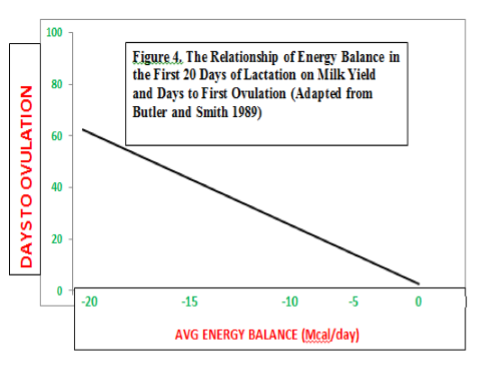Bypass Fats and Dairy Cow Reproduction
Posted by Dr. Jim Lofton on Nov 3, 2021 2:20:06 PM
What should you expect from your bypass fat supplement?
- Most importantly, the bypass fat must not depress DMI!
- The bypass fat must be high in NEL.
- The bypass fat must increase milk yield/components thereby increasing the value of the milk production.
- The bypass fat must not interfere with normal rumen function.
- The bypass fat should reduce negative energy balance in early lactation allowing the return to estrus.
Bypass fats have been shown to improve milk yield, milk components, and NEL. intake compared to control (Sellers, et al 2017). The 25 Energy Booster trials did not reduce DMI due to its stearic acid content. The seven enriched palmitic acid (PA) feeding trials resulted in a reduction of 1.15 lb./d in DMI (P=0.009) while 31 calcium salt (CS) feeding trials resulted in a reduction of 2.01 lb./d in DMI (P<0.001). All products were compared to control. The ability of the bypass fat to provide more energy without decreasing DMI has been grossly overlooked. Reducing negative energy balance (NEB) in the first 21 days post-partum has been shown to have profound effects on days to first ovulation as illustrated in Figure 1 (Butler and Smith 1989).
Figure 1. Effect of Energy Balance on days to first ovulation.
As illustrated in Figure 1, increasing the NEB the first 3 weeks of lactation greatly increases the days to first ovulation.
A more recent research trial measured the effects of PA on fresh cows (de Souza et al. 2017) which resulted in 30 kg more weight loss than control when fed at 1.5% of diet DM. This is shown in Figure 2.
Figure 2. The effect of PA on body weight loss in fresh cows.
 PA treatment resulted in increased plasma NEFA concentrations and reduced insulin which are key indicators of body fat mobilization (de Souza et al. 2019). Several early lactation Ca Salt studies (Erickson et al., 1992; Sklan et al., 1994; Garcia-Bojalil et al., 1998; Moallem et al., 2007) report increased plasma NEFA values indicating mobilization of body reserves.
PA treatment resulted in increased plasma NEFA concentrations and reduced insulin which are key indicators of body fat mobilization (de Souza et al. 2019). Several early lactation Ca Salt studies (Erickson et al., 1992; Sklan et al., 1994; Garcia-Bojalil et al., 1998; Moallem et al., 2007) report increased plasma NEFA values indicating mobilization of body reserves.
It’s a fact that Energy Booster has not been shown to reduce DMI (Sellers et al 2017), cause excessive body weight loss in early lactation (Piantoni et al. 2015), or increased NEFA compared to control may lead to benefits that are beyond the economic improvements in milk and component yield. Several authors have demonstrated the relationship between energy balance, body weight, or body condition change in early lactation and subsequent reproductive performance (Butler and Smith, 1989; Jorritsma et al., 2003; Roche et al., 2007; Carvalho et al., 2014). Likewise, cows with increased plasma non-esterified fatty acid (NEFA) concentrations have a lower probability of conception by 150 days in milk (Westwood et al., 2002), as elevated plasma NEFA in early lactation are indicative of mobilization of body energy reserves (Adewuyi et al., 2005).
From many peer reviewed papers, one can reason that reducing DMI in the first 3 weeks after calving results in accelerated body weight loss and reduced BCS scores. High palmitic and Ca salt products do reduce DMI and the energy that cows realize from that added intake.
In order to determine the true value of a bypass fat supplement, one must measure the economic impact of accelerated body weight loss and reduced BCS on reproductive parameters beyond their impact on productive parameters.
A series of studies was conducted by Carvalho et al. 2014 where research was conducted on 3 commercial dairy farms and 1 research farm in south-central Wisconsin. The study was designed to test the effects of body weight loss and reduced BCS on several reproductive parameters. The results are shown in Table 1.
Table 1. The effects of body weight loss and reduced BCS during the first 3 weeks of lactation on reproductive parameters. (adapted from Carvalho et al. 2014)

In this study, improvements in BCS in the first 21 days post calving resulted in significantly higher pregnancy per AI (P/AI) at 40 or 70 days. The authors felt clear that greater BW loss during the early postpartum period provided important evidence for a carryover effect of NEB on embryo development 6 to 7 wk later.
Other previous studies found similar effects of BCS on reproduction:
BCS Loss and Days to Conception
- +12.2 days with 1-unit BCS loss (Gillund et al., 2001)
- +31 days with >1-unit BCS loss (Ruegg and Milton, 1994)
- +27.75 days with 1-unit BCS loss (Avendano-Reyes et al., 2009)
- +10.6 days with >1-unit BCS loss (Lopez-Gatius et al., 2003)
- +15.5 with a 1-unit BCS loss (Calculated from calving interval; Pryce et al., 2001)
BCS Loss and Days to First Service
- -48% (65 vs 17%) with >1-unit BCS loss (Butler and Smith, 1989)
- -17.25% with 0.40-unit BC loss (Domecq et al., 1997)
- -20.13% with 0.80-unit BCS loss (Domecq et al., 1997)
BCS Loss and Services Per Conception
- + 0.5 SPC with >1-unit BCS loss (Butler and Smith, 1989)
- + 0.22 SPC with 1-unit BCS loss (Gillund et al., 2001)
- + 0.47 SPC with >1-unit BCS loss (Ruegg and Milton, 1994)
Summary – Decreased Reproductive Efficiency with BCS Loss and Its Economic Impact
- Days to conception: +19.4 days open with a 1 unit or greater loss in BCS
- 1st service conception rate: -19.77% FSCR with 0.4 – 1+ unit loss in BCS
- Days to first service: +8.5 days to FS with a 1 unit or greater loss in BCS
- Services per conception: +0.40 SPC with a 1 unit or greater loss in BCS
Economic Impact of BCS Loss
- Days to conception: $2.75/cow/day – De Vries, 2011; Plaizlier et al., 1997; French and Nebel, 2003; Inchaisri et al., 2010; Mohamed et al., 2014
- 1st Service conception rate: $2.19/%/cow/yr. – Marsh et al., 1987; Boichard, 1990
- Increased days open: $4-$7/day from 115-145 DIM – Valergakis et al., 2007
- Services per conception: $15/cow/service – Dairy Cattle Reproduction Council; Lima et al., 2010
- Days to conception: $2.75/day x 19.4 days = $53.35/cow
- 1st Service conception rate: $2.19/% x 19.77% = $43.30/cow
- Services per conception: $15/service x 0.40 services = $6.00/cow
The reproductive economic benefit of Energy Booster 100 over and above other bypass fats that cause reduced DMI and higher BCS loss in the first 21 days post calving leading to increased days to conception, increased 1st service conception rate, increased days open, and increased services per conception is >$100 per cow per year. At todays prices, that’s enough Energy Booster 100 to feed a lactating cow 0.65 lb./d for half of her lactation. That’s a lot of free milk and components.
What it boils down to is this—if your bypass fat can’t deliver reproductive benefits similar to Energy Booster 100 because it depresses DMI and reduces net energy intake leading to excessive body weight loss and BCS loss—you can’t afford it!
Topics: ANIMAL NUTRITION
